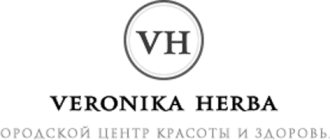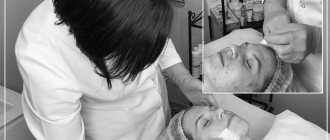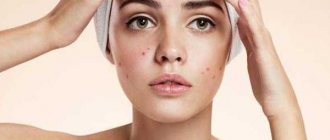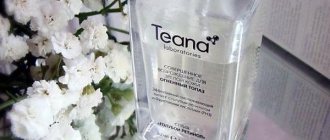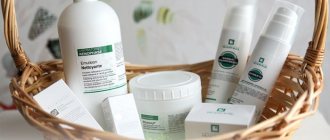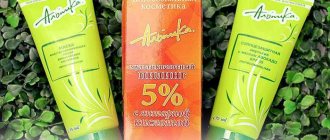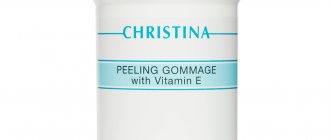Peeling programs allow you to gently remove dead cells, providing healing and rejuvenation processes. The active components of professional products dissolve the surface layer of skin, which is replaced by newly created tissue. Different concentrations of acids affect the surface, middle levels. The degree of penetration is regulated by specialists, exfoliation successfully copes with the problems of age-related, tired, oily dermis. As a result of the session, the face looks fresh, well-groomed, and rested. It is possible to even out the relief, reduce the number and depth of wrinkles, and increase elasticity.
The RENOPHASE laboratory has been developing products for face and body care for over 25 years. There are both professional and home programs that ensure long-term preservation of a blooming appearance. Renofaz peeling should be considered as a rejuvenation procedure before an important event. The absence of a recovery period allows you to immediately evaluate the result. The cosmeceutical line is designed to normalize metabolism and activate renewal. Successfully copes with traces of photoaging, sagging, loss of elasticity, is used to treat acne, and removes hyperpigmentation.
About company
The RENOPHASE laboratory was created in 1984 in France; today, research clinics and factories for the production of raw materials are located in Switzerland and Canada. The main activity is aimed at restoring skin balance, accelerating regeneration processes with maximum tolerance. A non-invasive restructuring technique is considered the most effective for achieving lasting rejuvenation. Research in the field of phototherapy has made progress in the field of photobiostimulation.
Main achievements:
- In 1987, studies were conducted on vascular oxygenation.
- In 1995, after the active use of fruit acids in the beauty industry, the company created a unique biocompatible formula based on glycolic acid for sensitive skin.
- In 2003, the laboratory began developing products for aging skin after 50 years. The antioxidant diosgenin was synthesized, canceling the effect of the passage of time on the skin.
- In 2007, innovative products for photorejuvenation were synthesized.
- In 2012, a formula based on the patented 5-CR chlorophyllin is a discovery in the tissue photorejuvenation system.
The products comply with international standards and are certified in Russia. To carry out the procedure, a specialist must be trained in the protocol for using professional products. The schedule of seminars and the purchase of the French cosmetic line is carried out through the distribution network.
general description
The French brand Renophase was created in 1984. The main activity of the laboratory is the creation of drugs that restore skin balance and accelerate regenerative processes.
There are professional and home programs that normalize metabolism and activate renewal. The author of peeling compositions, Dr. Michel Imar, has developed a series of exfoliants that differ in content and focus.
The choice of product and the number of sessions depend on the condition of the dermis, its sensitivity and other individual characteristics of the body.
Peeling from Renofaz takes a leading position because it provides a good visual effect after one or two procedures, is suitable for women and men of any age and is performed without seasonal restrictions.
Compound
Contains glycolic and hyaluronic acids, phytoestrogens, multivitamin combinations.
Thanks to its multicomponent properties, lasting rejuvenating and healing effects are ensured. The most important components of the product are:
- Hydroxyacetic acid is the basis of all products in the series, has antioxidant properties and slows down the aging process. Combines well with other substances.
- Genistein (soybean phytoestrogen) is a natural antioxidant with a bactericidal effect. Solves the following tasks: strengthens vascular walls, normalizes sebum production, stimulates tissue renewal and regeneration.
- Diosgenin (phytoestrogen from wild yam) is a glycoside of plant origin that normalizes hormonal balance in the dermis, improves metabolism, firmness and elasticity of the epidermis. Its action minimizes puffiness, removes pigmentation and evens out skin tone.
- Vitamins A, C - promote tissue restoration, give radiance and healthy color.
Buyanov Sergey Yurievich (Expert Doctor):
Estrogens of natural origin have the same properties as substances synthesized in the body. Fresh cell growth hormones.
Efficiency
Gentle removal of keratinized dermis triggers rejuvenating processes. Active substances dissolve the upper layer, stimulating the formation of new cells. The skin is refreshed, renewed and absorbs caring cosmetics well.
Exposure to acids occurs at the surface and middle levels, and therefore does not cause negative consequences.
Renofaz peelings even out the surface, reduce the number and severity of wrinkles, and increase elasticity. Their use provides:
- elimination of scars;
- lightening pigment spots;
- removal of puffiness;
- subsidence of inflammatory processes;
- resorption of hardening after acne;
- strengthening the internal structure of the dermis and blood vessels;
- reducing the manifestations of rosacea.
Indications:
- oily, porous, dense skin;
- acne in papular form (without pus);
- acne scars;
- comedones;
- hyperpigmentation;
- dull, unhealthy complexion;
- sagging, loss of elasticity;
- age-related changes (expression wrinkles, nasolabial folds).
Review of peelings
The Renofaz line includes the following exfoliant options:
Keratoregulating
Peeling is intended for the care of oily, problematic dermis, with periodic inflammation and acne. Effectively tightens pores, restores relief, normalizes gland secretion. After exfoliation, it is possible to restore an even texture, smooth out acne marks, and whiten pigmentation. Activation of blood flow helps to normalize intracellular processes, reducing the synthesis of sebaceous secretions. The composition contains glycolic acid, soybean phytoextract, vitamin C. You can purchase it in the online store, the cost of 30 ml is about 10,300 rubles.
Indications:
- greasy shine:
- comedones, sebaceous plugs;
- blackheads, acne;
- uneven, unhealthy color;
- dense lumpy skin.
Renewlift
Peeling is prescribed for non-surgical facelift, to increase tone, normalize nutrition and breathing processes. As a result of the procedure, the synthesis of collagen and hyaluron is stimulated. It is possible to prevent ptosis thanks to a persistent lifting effect. Recommended for aged dermis with signs of chronoaging, ptosis, and pronounced wrinkles.
Attention! Thanks to the cosmetic product, the cellular matrix is restored, density increases, and hydrobalance is normalized. Usually 1 procedure is enough, after which maintenance care with professional products is required.
Ingredients: partially neutralized glycolic acid 68%, diosgenin, Asian centella extract. You can purchase 30 ml on the website of the official distributor of the French laboratory for 10,440 rubles.
Indications:
- traces of age-related changes;
- loss of elasticity, sagging;
- unhealthy color, age spots;
- wrinkles of varying degrees.
Reprogramming
Peeling is used for thin, sensitive skin with signs of aging. Promotes the reconstruction of the dermal matrix, helps compact the collagen framework, and restore the protective barrier. It has pronounced oxidant properties, stimulates the elimination of toxins and metabolic products. Normalizes hydrobalance, resulting in increased synthesis of hyaluronic acid. After the procedure, the face looks renewed, fresh, the skin becomes less susceptible to the influence of external aggressive factors.
The number of sessions is determined by the cosmetologist individually; the standard requirement is 7 to 10 procedures at intervals of once a week.
Indications for use:
- dry, dehydrated, stressed skin;
- photoaging;
- presence of wrinkles;
- preparation for surgery and recovery period after;
- hyperpigmentation.
The composition of the hydrogel is salicylic acid 4%, a precursor of hyaluronic acid, retinol, genisten, tocopherol, an ether form of vitamin C. The peeling contains glycolic acid 70%, soy extract, genistein. Cost 30 ml 10080 rub.
The main thing about Renophase peeling
| Type of peeling | chemical |
| Peeling type | surface |
| Skin type | for all skin types |
| Active substance | glycolic acid, soy phytoestrogens, vitamins A and C |
| Application area | face, neck, hands, décolleté |
| Pre-peeling preparation | not required |
| Anesthesia | not required |
| Post-peeling care | desirable |
| Contraindications | There is |
| Price of one procedure in the salon | from 2,500 rubles |
| Number of sessions | 6-8 procedures, performed one at a time every 7 days |
| Home procedure | No |
| Analogs | almond peeling milk peeling |
| Seasonality | can be done all year round |
How does the procedure work?
Protocol:
- Cleansing with foam selected according to skin type. After makeup removal, the composition is washed off with water.
- The application of hydrogel, the formula of which contains active elements, has a healing effect on the skin.
- Treatment with peeling composition, absorption time from 7 to 12 minutes. A neutralizer is applied to regulate the effects of the ingredients.
- The product is washed off with cold water, and excess moisture is removed with a sponge.
- At the next stage, a soothing mask with a regenerating effect is used.
- Afterwards, apply a cream selected according to your skin type.
Peeling
For the procedure to be effective and without consequences, the following conditions must be met a week before the session:
- stop tanning;
- do not visit the bathhouse, sauna, swimming pool;
- do not carry out other cosmetic procedures;
- choose a cream for hypersensitive skin;
- When outside, protect your face with cream with SPF 30 or higher.
How it goes
Be sure to test for an allergic reaction, after which the cosmetologist selects the optimal composition of the exfoliant.
Next, a certain sequence of actions is followed:
- Removing decorative cosmetics, dust and other contaminants with soft milk, gel or lotion.
- Degreasing with hydrogel with active ingredients.
- Apply the cleansing composition using a synthetic brush, absorption time is from 7 to 12 minutes.
- Neutralization of acid with a special agent.
- Cleaning the neutralizer with a large amount of water, removing residual moisture with a sponge.
- Carrying out a soothing mask.
Course duration
On average, a peeling course consists of 8 procedures. There should be at least a week break between sessions. Frequent use of acids can result in drying out the top layer of the coat, so several cleanings throughout the year are recommended.
Skin care after exfoliation
The procedure does not cause any discomfort; during the first hours, only redness of the integument is possible. There is no recovery period, so you can perform it at any convenient time. To achieve the desired result, you should follow the recommendations of the cosmetologist:
- limit touching the skin;
- do not use decorative cosmetics for 24 hours;
- for facial care, use soft gels and foams, alcohol-free tonics;
- actively use creams, serums, masks with moisturizing, nourishing, regenerating properties to restore the protective barrier of tissues;
- During the week it is not recommended to sunbathe, visit a bathhouse, sauna, swimming pool, play sports, or drink alcoholic beverages;
- the restoration of integument is affected by compliance with the water regime; it is advisable to drink at least 2 liters of water per day;
- Be sure to use sunscreen before going outside; a cosmetologist will help determine the protection factor, according to your individual phototype and time of year.
Experts explain whether it's worth overpaying for facial care products
Cosmetic products, like most other goods, are divided into three price categories - mass market, premium and luxury. Creams of the first category cost on average up to 1.5 thousand rubles, the second - up to 4 thousand, the luxury category - ad infinitum. Price formation is influenced by several factors - the cost of raw materials, packaging costs, the work of technologists, advertising, logistics, markup for the brand, batch size.
“The technology for producing high-quality cream has long been known and is in some ways standard: melter, reactor, homogenizer (this is what determines the quality of the final organoleptics of the cream), vacuum system. Next comes automated packaging,” cosmetic chemist-technologist Anna Sharova
.
A specialist, therefore creams even with a seemingly similar composition can be located in different price segments.
The composition on the cream label must be stated in accordance with INCI - International Nomenclature of Cosmetic Ingredients. The main goal is to give the buyer the opportunity to understand whether the composition contains components that cause him an allergy. Ingredients, according to INCI, are listed in descending order of their concentration in cosmetics. This rule applies to all ingredients whose concentration exceeds 1%.
According to chemist and beauty blogger Yulia Sotnikova
, raw materials are the first criterion for distinguishing between expensive and budget creams. “The components may be in identical positions “at the end” or “at the beginning” of the list, but this does not indicate the identical quality of the raw materials,” the specialist explains to Gazeta.Ru.
The enhancer system plays an equally important role - this is what makes cosmetics work: the more complex it is, the higher the price of the product. “Alcohol, essential oils, moisturizing components - all of this refers to enhancers, and these are quite inexpensive and common systems,” says Yulia Sotnikova. “Another thing is liposomal encapsulation: it involves placing the active molecule in a fat-soluble sphere, which allows the active to be delivered through the stratum corneum into the epidermis.”
Active components also add to the price tag, the expert believes. For example, ascorbic acid is an expensive and “problematic” component. To prevent the product from oxidizing due to it in the first month of use, it must be properly dissolved and stabilized.
“Budget products try to handle the actives by placing them on a fat-soluble base; more expensive brands place the molecule in a liposome, which allows the active to be delivered to the epidermis,” Sotnikova said.
Luxury brands often justify the high price of their products by the presence of unique ingredients in the cream.
As Guerlain care expert Ekaterina Gvoskova notes in an interview with Gazeta.Ru, one of the brand’s lines, Abeille Royale, is created from Ouessant honey, which is produced by a black bee living on the French island of Ouessant. And Tatyana Pyatakova, a leading cosmetologist and expert of the La Mer brand, clarifies that to create some of the company’s creams, rare algae are used, which are collected by hand twice a year on a certain day and time when their activity reaches its peak. In addition, creams sometimes contain black caviar, black truffle, DNA and RNA derivatives, peptides, and precious stones.
Victoria Klishko tells Gazeta.Ru.
. “They use the placenta of animals that have just given birth to create their creams.” She adds that cell and placental technologies are considered the most expensive.
Alexander Mineev, founder of the Russian cosmetics brand Seveki
, in a conversation with Gazeta.Ru, he admits that the company’s pricing, on the contrary, does not include advertising, it does not sell goods in expensive packaging, and does not make a large markup.
“We try to make the packaging cost commensurate with the contents. If the product itself is not very expensive, then we use a cheaper bottle, but this does not mean that it is worse. For example, a glass bottle costs less than a plastic bottle with a vacuum dispenser,” Mineev gives an example.
To summarize, chemist Yulia Sotnikova notes that there is certainly a difference between expensive and budget creams. This rule does not work for all market participants, but “leaders keep pace with scientific research, for which they themselves allocate money in order to develop.” The expert is sure: there is no need to overpay when you can find cheaper alternatives.
“In any case, the product will not jump above its head and will not correct what cannot be corrected from a biological point of view,” argues Sotnikova.
Cosmetologist Victoria Klishko warns that there are things you shouldn’t skimp on - cleansers, serums, products for caring for the skin of the neck and around the eyes. But it makes sense to buy an expensive cream when you really have a problem - for example, pigmentation, rosacea, acne, serious changes at the level of the collagen and elastin framework.
Precautionary measures
Before testing, you should test for a possible allergic reaction. Also, the cosmetologist must select the optimal composition to prevent burns and hypersensitivity. It is important to maintain the exfoliation time, so you can only entrust the procedure to a professional.
Important point! In rare cases, side effects are possible in the form of prolonged redness, peeling, and painful sensitivity. All symptoms quickly disappear with the use of moisturizing and regenerating agents.
Contraindications:
- pregnancy, lactation;
- foci of herpes;
- eczema, psoriasis, dermatological diseases in the relapse stage;
- oncology;
- pathologies of the cardiovascular system;
- fresh tan;
- injuries, microcracks, burns;
- a large number of moles, papillomas.
Advantages and disadvantages
The use of peelings is possible only in a salon, home use can lead to complications, and it is difficult to achieve the effect declared by the manufacturer. Formulas with glycolic acid ensure that there is no recovery period, so you can safely prescribe the procedure before an important event. The number of sessions is determined individually by a cosmetologist, after assessing the condition of the integument and the goals of therapy. Exfoliation is often performed in preparation for various invasive and hardware procedures.
Pros:
- rejuvenation, general improvement of skin condition;
- the effect can be assessed after the first session;
- there is no recovery period;
- there are no age restrictions for conducting;
- the ability to select a product individually;
- suitable for use by all types, including sensitive dermis;
- allows you to solve a whole range of aesthetic problems.
Minuses:
- high cost of the procedure compared to other professional peelings;
- carried out by cosmetologists after completing training.
Cost of the procedure in salons
Renofaz peeling complexes are intended for professional care, and therefore must be carried out by specialists who have undergone special training.
When used at home, there may be no results and unpleasant consequences.
You can buy the company's products from the official distributor. The cost of the set, which includes almond, glycolic and other products, may vary depending on promotions and special offers.
In the salon, one procedure costs about 6,000 rubles.
Average price in Moscow:
- renewlift - 5,500 rubles;
- keratoregulating - 3,200 rubles;
- depigmenting — 4,000 rub.
Opinion of cosmetologists
Professionals discuss the specifics of using acid compounds, their effect, and possible consequences.
The cosmetologist asks his colleagues what could cause the client’s cheeks to become red after the 4th procedure.
The user writes that she switched to cheaper peeling lines, but the results are terrible. The product does not meet the quality declared by the manufacturer.
The specialist answers the client’s question: glycolic peeling 70% is not recommended for thin, sensitive skin. It is better to use no more than 30%, 50%.
Patient reviews
On the Internet you can find many reviews about peeling in a salon. If the protocol is followed, as well as with the correct drug, the result exceeds all expectations.
A member writes about a good effect for removing acne spots.
The user indicates that if the procedure is effective, the recovery period can be experienced at home, the main thing is to choose the right time for the procedure.
The user writes about the dependence of the result, side effects and individual characteristics of the skin.
But there are also negative reviews after peeling. The participant writes about the exacerbation of acne, the deterioration of the general condition of the skin, the appearance of scars, scars, and spots.
